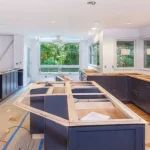Steel is becoming a favored construction material in the UK because of its prospective benefits, especially in residential constructions. The industry is seeking ways to optimise its resources because of the anticipated demand through 2025.
The projection is very promising due to the high economic advantages, increased durability, and enhanced longevity offered by steel.
Durability and Structural Integrity
Withstanding harsh environmental changes, like extreme weather, can pose a challenge to the durability of these homes. It is a relief that the modern world is continually changing, as will the industry’s requirements. One of the greatest attributes of steel is its Extreme Resilience. In terms of rot, fire, pest resistance, and overall durability, timber simply cannot compete with steel.
Furthermore, residential structural steel beams outlast other materials in endurance and durability.
Sustainability and Environmental Impact
Modern sustainability focuses a lot on reuse, which steel excels in. Steel’s sustainability makes a very strong case for its use as steel is roughly 96% reclaimed and recycled during construction and infrastructural works in the UK. This reduces wastage significantly. Additionally, modern advancements in processes around steel manufacturing result in increased energy efficiency, further decreasing emissions.
Energy Efficiency
Steel-framed constructions use advanced energy-efficient insulation. Green roofing and solar panels can be seamlessly integrated into the framework, contributing to a more sustainable structure, while steel roofs enhance overall structural strength.
Accompanying the green features, the use of insulation helps minimise the loss of heat during winter and prevents excessive heat levels during summer, increasing efficiency while further decreasing power consumption.
Economic Advantages
Due to automating the processes of prefabrication of steel components, steel parts are manufactured in a controlled environment and assembled at the site, which shortens the construction schedule.
This not only reduces labor costs but also enables the advanced completion of the project, which is economically beneficial to the developers and the homeowners. The maintenance-free, long-lasting structures are cost-effective due to their economical steel frameworks.
Cost Implications
Considering the use of steel within the framework of residential construction requires analysing both direct and indirect financial impacts.
- Initial Costs: Due to steel’s superior strength-to-weight ratio, lighter structures can be built, which reduces foundation and related expenses. Also, for quicker construction, labor costs could be minimised due to the prefabrication of steel components.
- Long-Term Savings: The lifespan of a structure increases significant cost savings with steel’s durability and low maintenance needs. Expensive repair and replacement costs due to pest, rot, and fire damages are avoided with the use of steel, enhancing durability.
The construction sector does face challenges with rising material costs. Steel’s material costs are predicted to rise by 15% in that timeframe. Due to surge on the National Insurance Contribution and the National Living Wage, an 18% increase in labor costs is expected.
Design Flexibility
Because of the versatility of steel, architects and builders waste no effort in their designs. The weight of the steel enables longer spans as well as open-plan interiors which greatly reduces the need for supporting columns. This is especially helpful in residential construction as the increasing demand prefers adaptable living spaces.
Challenges and Considerations
It might be a surprise that employing steel in residential construction comes with its fair share of issues. The UK steel industry is struggling financially, with debates on nationalisation and the need for modernisation to adopt cleaner technologies. For example, British Steel’s Scunthorpe plant has been the interest of such debates, showcasing the need for reliable domestic steel supplies for construction.
The plant has about 3,500 employees and supplies most of Britain’s rail track steel. Weighted average Scunthorpe has become the focus of controversy because of Britain’s constant disregard for more favorable strategies. After failing to negotiate a financial support deal to implement greener technology and enduring Trump’s rising tariffs, which have disrupted global markets, nationalisation is seen as a tactical solution.
There is pressure on the government from economic and political camps such as Reform UK leader Nigel Farage, who urged them to act within days to stop furnace shutdowns. The government led by Starmer has focused on the lack of the steel industry’s importance at the beginning and is poised to enact punitive measures, but unlike going to war, they are attempting to resolve the United States’ conflicts through diplomacy.
Also, a lack of skills leaves a gap in the construction industry, particularly in newer technologies and aspects of sustainable building practices. Filling this gap is vital to take advantage of steel’s full benefits in residential construction.
Conclusion
Steel imposes great value in the long term in residential construction due to the great focus on resilient building practices within the United Kingdom. The material’s durability, capacity to be recycled, efficiency of energy used and economic value, as well as flexibility for design makes it suitable for modern homes.







